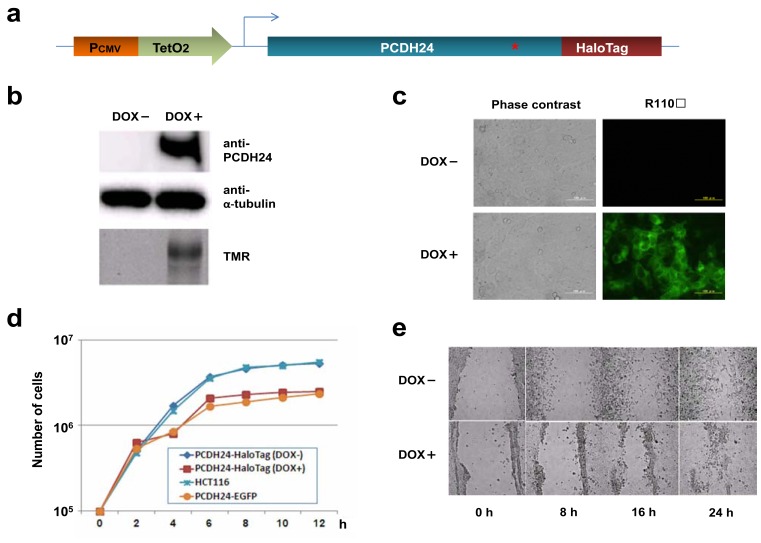Fig. (1). PCDH24 induces morphological changes and affects cell saturation density in HCT116 cells.
(a) Schematic representation of the PCDH24-HaloTag expression clone. The expression of PCDH24-HaloTag is regulated by the CMV-TetO2 promoter, which is induced by DOX through the tetracycline repressor-operator system. A red asterisks indicates a transmembrane region of the PCDH24. (b) Inducible expression of PCDH24-HaloTag in the HCT116 PCDH24-HaloTag stable cell line. Lysates from HCT116 PCDH24-HaloTag cells with or without DOX (1 μg/mL; hereafter DOX induction is under identical conditions) were separated on SDS-PAGE and the expression patterns of PCDH24 were analyzed by Western blot using an anti-PCDH24 polyclonal antibody. As a control, α-tubulin was detected with an anti-α-tubulin antibody. PCDH24-HaloTag in the cell lysate was labeled with TMR HaloTag® ligand and detected by a FluoroImager FLA-3000 (Fujifilm). (c) Typical images of the subcellular localization of PCDH24-HaloTag. HCT116 PCDH24-HaloTag cells were cultured with or without DOX. The cells were observed by phase contrast and fluorescent staining with the HaloTag® R110Direct™ ligand using an Axiovert S100 microscopy system. The scale bar indicates 100 µm. (d) Saturation density of HCT116 and HCT116-PCDH24 stable cell lines. 1.0 × 106 HCT116 cells, HCT116-PCDH24-EGFP cells, or HCT116-PCDH24-HaloTag cells with or without DOX were cultured in 35 mm dishes. Triplicate dishes were counted at the indicated time point of the growth curves, and each number represents the average value. (e) Effect of PCDH24 on cell motility. Photographs were taken 0, 8, 16 and 24 h following wound injury using a Biozero microscopy time-lapse system.

